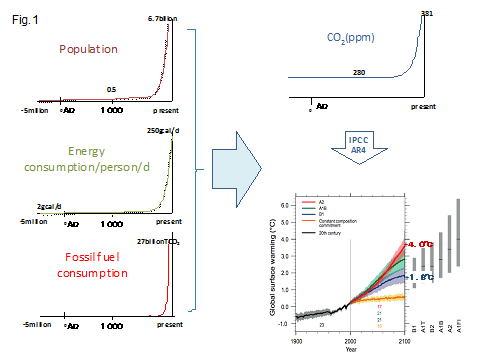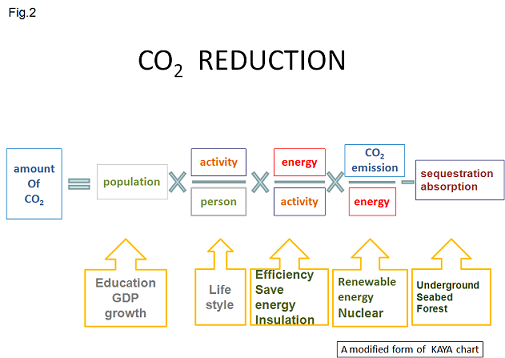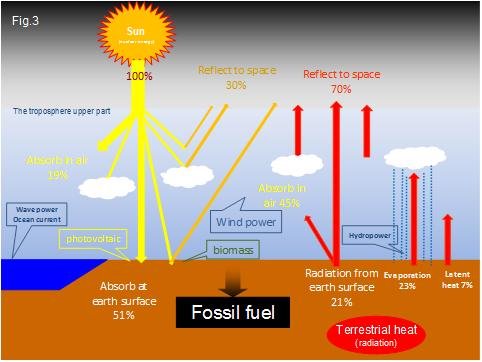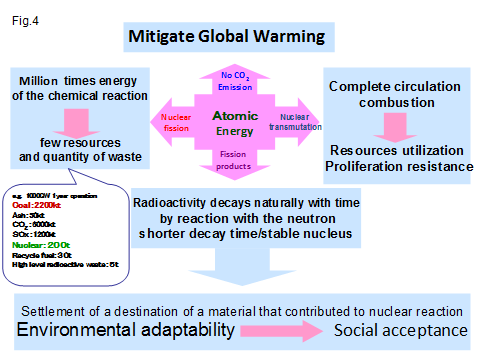1. The Human and energy
A human being needs about 2,000 kilocalories of energy per day to live. He/she has formed groups to make up a society, and the society has been civilized since the beginning of the human history. For this, the human race had to find energy supply. Science and technology have progressed as the means to do this. In history, wars have broken out to keep enough energy. And now, we live in the civilization which uses more than one hundred and thirty times as much energy as before.
The Industrial Revolution in the middle of 18th century developed the modern culture, and economic development induced by industrialized society brought a richer lifestyle. This prosperity is results from having enough fossil fuels such as coal, oil and natural gas, instead of plants. In only 100 years, human transportation changed from stagecoaches to cars on the ground, from sailing boats to steamships on the sea, and to aeroplanes in the air. Fossil fuels support the energy source to produce material and machinery on which richness depends. Even the electric energy, the most convenient one, is produced by fossil fuels. The atmospheric carbon dioxide concentration was almost 280ppm, unchanged from before the Industrial Revolution. However, with the increase use of fossil fuels, exhaust and absorption of carbon dioxide on the earth became unbalanced, which raised the concentration more than 380ppm (Figure 1).

The production of fossil fuels has grown in proportion to the cultivated population which has increased exponentially. People have even resorted to wars to secure energy. Wars accelerated the progress of technology, and technology brought the postwar industrial and economic development. That civilization was supported by mass-production, mass-consumption, and mass-abandonment of products after their use. However, facing the environmental problems and energy dry-up such as pollution, acid rain, ozone holes, global warming, and peak oil, human beings came to share a recognition that the earth should be named “Spaceship Earth”.
An issue that, as global warming countermeasures, emission of greenhouse gases sould be reduced has been discussed at the UN even though there are many difficulties for cooperation because of the North-South divide
Thus, it is clear that the shift from fossil fuel to new energy is demanded while maintaining modern civilization which was supported by rich fossil fuels since the Industrial Revolution. This is why development of “green energy” is most needed now.
Thus, it is clear that the shift from fossil fuel to new energy is demanded while maintaining modern civilization which was supported by rich fossil fuels since the Industrial Revolution. This is why development of “green energy” is most needed now.
Green energy as a means to stop global warming is widely expected to produce no ( or less ) greenhouse gas, and to suppress or eventually stop global warming.
Green energy is defined as eco-friendly energy that does not emit carbon dioxide and toxic substances in the course of energy production. So called natural energy utilizes resources such as solar light and heat, wind power, water power, biomass using excretion of domestic animals, wooden resources, farm product wastes, subterranean heat, and the ocean tides and the waves. This energy has been widely used but not a major source of energy. However, in the modern society which demands a low-carbon environment, natural energy has been developing rapidly with subsidies and technical progress since it has become clear that fossil fuels have negative effects on nature.
There is also green electricity* which evaluated environmental value. This was born in the beginning of 1990's that assumed consumerism as a background factor in the U.S.A., but then, green electricity developed in various forms, and more than 10 years has passed since its introduction.
*To make natural energy become widespread, a grant has been made toward green electric power based on its harmlessness to the environment. With the grant, green electric power could be competitive with others.
However, it is impossible to substitute small-scale green energy to support modern civilization which depends on mass fossil fuel energy. It is necessary to reduce energy consumption itself and to pursue sustainability of fossil fuels by applying carbon capture and storage (CCS) technology (Figure 2).

2. Green New Deal
In the UK, the Green New Deal Group, a group of experts in finance, energy and the environment, came together to released a report in July 2008. In this report, "Green New Deal" was proposed against the "Triple Crunch”, i.e. the credit crisis, climate change, and high oil prices.
Afterwards, the International Energy Agency (IEA) called for "a global revolution" to halve energy-related global CO2 emissions by 2050 at a cost of $45 trillion, which was approved by Prime Minister Gordon Brown and President Nicolas Sarkozy. In October, a report titled “Green Economic Initiative” was issued by United Nations Environment Programme (UNEP). Based on this concept, U.N. Secretary General Ban Ki-moon expected a new president of the United States to reflect the idea of “Global Green New Deal (GGND)” to his new policies. Mr. Frank-Walter Steinmeier, German Foreign Minister also expressed the same concern to Mr. Barack Obama upon his triumph to the US presidency. The more Triple Crunch has worsened, the more the expectation to GGND has grown., Now, his GGND policy is welcomed all over the world.
The contents of GGND are overwhelmingly filled with renewable energy. The Internet and IT , and financial and housing investment promoted economy in 1990's and 2000’s, respectively. Now renewable energy is expected to play such a rule afterwards.
It is said that renewable energy may play a similar part in the 21st century as cars did in the 20th century. Now renewable energy industry has been growing up, and is expected to expand to the same level as that of the car industry. Large scale investment all over the world in a low-carbon society infrastructure such as clean energy cars, insulated houses, the update of the transmission network is also expected to stimulate the global economy.
3. Atomic energy
The reason why atomic energy is not stated clearly in Green New Deal may be because people are still afraid of three unsolved problems about atomic energy. They relate to safety, nuclear proliferation and high-radiation nuclear waste. The opposition groups always exaggerate these problems. So, it is necessary to overlook the differences between nuclear energy and others.
From the beginning of cultivation, all materials, energy, technology, and information have been used both in welfare of human beings and in wars. In this point atomic energy is the same as other energy.
Atomic energy seems to be special in comparison with other energy. In fact, it is necessary to understand the origin of space as being ignited by nuclear reaction. During the expansion of the universe since Big Bang, materials from supernova explosions constituted the earth. The heat source of the magma in the earth’s crust is radiation energy from radioactive materials, and geothermal power generation depends on this heat. Photovoltaic generation utilizes solar thermal energy created by the fusion reaction of the hydrogen inside the sun. Carbohydrates are produced by photosynthesis which uses sun light as energy source, and then the carbohydrates are utilized as biofuels, or changed to fossil fuels. Wind power is generated by atmospheric circulation driven by the solar heat, and ocean current generation and wave power generation depends on currents and tides by winds. This means that the original resource of all the energy is atomic energy (Figure 3).

Now the human beings can control nuclear fission energy with technology. However, Natural Fossil Fission Reactors were discovered in Oklo, Gabonese Republic in 1972. About two billion years ago, oxygen produced by cyanobacteria oxygenated uranium, which caused uranium to fracture. The fractured uranium dissolved in water, and accumulated so that the concentration of uranium 235 became high enough for the chain reaction of nuclear fission. This indicates that atomic energy use natural resources as the same as other energy.
Nuclear reaction produce a million times as much energy density as that of chemical reaction of the fossil fuel combustion. As a consequence, nuclear energy was used as weapons during the war, which made the usage of this energy difficult from the viewpoint of nuclear nonproliferation afterwards.
Light water nuclear reactors spread widely around the world use the heat produced by the interaction between the material and radiation by nuclear fission. The technology used in this process is almost same as in thermal power generation by fossil fuels. Radioactive rays are used not only in medical treatment, agriculture, industry, but also in many fields of scientific researches. Thus, atomic energy cannot be replaced by other technologies.
As mentioned specifically above, renewable energy is generated from recurring phenomena in nature, compared to fossil fuels have a limit and destined to run out.
According to “World Energy Outlook (WEO 2008)”, the world energy demand in 2030 would increase 45% from that in 2006, so International Energy Agency (IEA) appeals for the necessity to take measures promptly to find other energy supplies and to prevent global warming. It is estimated that to limit a rise of the world average temperature to less than 3℃、a concentration of CO2 must be stabilized at 550ppm, low greenhouse gas emission worldwide to less than 33 Gton by 2030 must be achieved, and be kept reduced in the long term afterwards. This requires a ratio of low carbon energies (renewable energy, thermal power, with CCS, nuclear power, etc) to primary energy to be increased to 26% in 2030 from 19% in 2006, and grants related to energy to be increased more than 4.1 trillion dollars (0.2% of the annual world GDP ).
Carbon dioxide had been fixed underground in hundreds of millions of years, but the human race has been consuming as fossil fuels and emitting the gas into the atmosphere in only about 150 years. To deal with this problem, many countries has been trying to develop renewable energy. With the limitation of the geographic restrictions, however, such as winds for wind power, or as necessity of wide open space like dessert for solar power, and with its high expense because of low energy density, societies might not be able to bear economic burdens. In addition, energy supplies depending on weather are unstable, and a great deal of backup power supplies are necessary to meet a large quantity of energy demands to continue current lifestyles, which make renewable energy unrealistic. Therefore, only by increasing renewable energy cannot satisfy demands in substitution for fossil fuels[1].
It is rational for us, seeking the sustainability, to use nuclear power instead of fossil fuels, since nuclear energy doesn’t emit carbon dioxide and its energy density is millionfold of chemical reaction energy. This indicates that revival of atomic energy use in the world is a natural tendency.
According to data of January 1st, 2008[2], the number of operating nuclear power plants is 435 in 13 countries and their total output is 392.241GW, sharing 15.2% of the energy supply. 43 nuclear power plants (38.772GW for total) in 13countries are under construction now, and 53 nuclear power plants (49.601GW) in 16countries are planned to be constructed. International Atomic Energy Agency[3] IAEA expects global nuclear power capacity to range from
473GW, 27% higher than today’s 372GW, to 748GW, i.e. double of today’s capacity.This indicates, though there are some differences among countries, that leaders recognize atomic energy is indispensable from the viewpoint of “BestMix**”. To think about energy policies, accurate data reflecting the status quo of each country is demanded.
** Energy sources are sorted based on their fuels such as petroleum and atomic power. These sources are combined optimally according to supply stability, economic efficiency, environmental and operating characteristics of each.
Since the end of the Cold War, negotiations to reduce nuclear weapons have started. Now global warming has become the center of worldwide concern. International negotiations towards common goals are underway while improving the North-South divide. Under these circumstances, it seems necessary to look on the peaceful use of nuclear energy as a part of transition of civilization. I summarize the superior characteristic of the atomic energy in Figure 4.

4. Three problematic reasons for not using atomic energy
In order to help society get used to the use of atomic energy as energy policy of BestMix, it is necessary for people to understand atomic energy as a whole objectively and with correct information. It cannot help but take time to remove a phobia about using atomic energy. Some people now seem to think that absolute measures to cope with the following three problems should exist. In reality, however, since such measures cannot exist, wisdom and efforts should be used to prevent them from emerging. We need to trust and monitor professionals who deal with these three problems.
However, lack of public education and exaggerated media coverage about the Chernobyl accident resulted in a big negative shock to society and prevented people from obtaining a full understanding of atomic energy.
As a result, there are 3 major reasons for and against the use of atomic energy.
Safety:
Debate about the peaceful use of the atomic energy started from safety considerations because of the incomparable power of nuclear energy.
It has been proven that nuclear energy is the safest industry product in terms of a safe system design, and societal requirements such as the regulation and the maintenance of facilities with a record of more than 10,000 reactor year of safe reactor operation.
However, people’s understandings about the damage caused by Chernobyl accident and its radioactive contamination to the human bodies originated in the anxiety people have about nuclear energy.
Therefore, dissemination of correct knowledge about nuclear energy is necessary.
Safety in nuclear energy use can be achieved if correct maintenance practices are observed.
In addition this prevents other troubles which do not directly endanger public safety such as human errors that cause accidents.
If people could understand that safety can be maintained by the effort of operators, there would be no “safety issues.”
Nuclear Proliferation:
With a global commitment to the peaceful use of atomic energy, efforts to prevent its conversion to weapons, that is to say, nuclear nonproliferation, have been continued.
Humans cannot help seeking not to proliferate through an international nonproliferation system.
Firstly, it is necessary to reduce the number of existing nuclear weapons, and to construct the system to prevent terrorists from accessing nuclear weapons.
This problem is the other side of the same coin as nuclear energy use.
High radio-active level waste disposal:
Among wastes from using the atomic energy, a high level radio-active waste and the long time it takes to lower radio-activity levels are major problems.
Thus to understand that radio-activity naturally disappears as time passes, and that we can convert the nuclide of a long half time into the nuclide of a short half time or a stable nuclide, will solve the problem. Research and development about this is under way.
Therefore, the current deep underground disposal is the safest method. Obtaining public understanding of this solves this problem.
5. References
[1] Yoichi Kaya, Yutaka Nagata, Keigo Akimoto “Low Carbon Economy - warming measure target and nation burden” Nihon Keizai Sinbun publishing company
[2] JAIF “The present conditions of the world nuclear power generation” January 1, 2008
[3] ”Energy, Electricity and Nuclear Power Estimates for the Period to 2030”, 2008 edition
|









